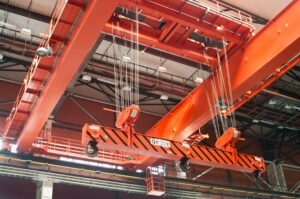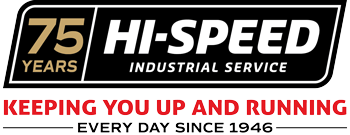 Hoists are an essential part of an overhead crane system and are responsible for lifting, lowering, holding, and moving heavy loads. However, choosing the correct hoist for your overhead crane involves more than just looking at how much it costs or how much load it can handle. Thought must also be given to the power required to run the hoist, the type of maintenance needed, frequency of lift, noise levels, and more.
Hoists are an essential part of an overhead crane system and are responsible for lifting, lowering, holding, and moving heavy loads. However, choosing the correct hoist for your overhead crane involves more than just looking at how much it costs or how much load it can handle. Thought must also be given to the power required to run the hoist, the type of maintenance needed, frequency of lift, noise levels, and more.
And don’t forget that manual, electric, and pneumatic hoists each have pros and cons — and you’ll need to decide whether wire rope or chain is what you need. In this blog post, we’ll discuss the basics of hoists, the benefits each provides, and an introduction to the difference between wire rope and chains.
Types of Hoists
Almost all hoists can be categorized into one of three types: manual, electric, and pneumatic. While they may look similar and perform the same task, they are all quite different in how they approach their job and the loads and environments they are best adapted to.
Manual Hoists
In a manual hoist, it’s the operator that provides the power. That power is multiplied enough to lift thousands of pounds — and even tons — through a pulley-like gearing system. These are probably the oldest form of hoists, and they do have some great benefits associated with using them:
- No issues with the cost of electricity to operate them
- They do not need to be located near a power source
- There are no issues with motors overheating
- Maintenance primarily involves lubrication
However, manual hoists depend on labor that eventually becomes tired, and some health issues can preclude people from working with them.
Electric Hoists
Electric hoists use powerful electric motors to provide lifting forces, offering quite a few benefits, including excellent lifting power. In addition, they are used in a wide variety of different industries. However, when selecting an electric hoist, there are some key things to remember. First, they consume electricity, which depends heavily on the lifts made per hour. If electricity usage costs are too high, getting a good return on investment may not be easy. Second, the electric motors in these hoists can overheat, mainly when used for long spans of time. This overheating can damage the motor and lead to other dangers as well.
Pneumatic Hoists
Pneumatic hoists, also referred to as air hoists, depend on pressurized air as the medium through which lifting power is transmitted and multiplied. They do have a motor, but pressurized air rather than electric power does the heavy lifting. Because air continually flows through the motor, it is kept at a much cooler temperature than the motor in an electric hoist. Here are some of the benefits of an air hoist:
- Run much cooler than electric hoists
- Do not require as much power as an electric hoist
- Depending on the hoist itself, they can lift loads on the order of hundreds of tons
They require close monitoring of airflow and pressure to keep the system operating at peak lifting performance, and they need significant maintenance. And while they don’t run on electric motors, they still require electricity to power the air compression system, controls, etc.
Wire Rope vs Chain?
The lifting medium for a hoist is also an important factor in its performance and capabilities.
Let’s start off with chain hoists. Chains can be used on all the hoists we’ve discussed and are known for relatively low costs and easy maintenance. While they may not run as quietly as wire rope hoists, they are more rugged and last longer — even when abused. Their primary limitations are maximum lifting capability (generally less than 25 ton), limitations in lift height, and slower lifting speeds than their wire rope counterparts. Also note that chains come in different grades that indicate their strength, with the most common grades being Grade 30, 43, 70, 80, and 100. In addition, chains are available in different finishes that can provide corrosion protection or a matte finish.
Wire rope can also be used on all three types of hoists, and offer quieter operation, lift capabilities that start at 10 tons, and a lower cost. Unlike wire chains, they do always require a cable drum to wrap around, which can cause them to take up more space than their equivalent chain counterpart. However, they support faster lifts, and some are appropriate for severe duty operation. Wire ropes fall under different classifications depending on key features such as the lay, grade, and finish.
Conclusion
Hoists are an integral part of the cranes in your facility as they perform the actual lifting, lowering, and holding required for successfully transporting loads. And it is extremely important that you choose the right hoist and lifting medium based on factors related to the loads (e.g., weight), operating conditions, the power required, duty cycles, maintenance requirements, and safety concerns.
At Hi-Speed Industrial Service, we’ve got 75 years of experience with helping our customers find the right solutions for their facilities — and hoists for overhead cranes are no exception. Whether you are purchasing a hoist for a new crane or replacing an existing hoist, our team will help you navigate the options available based on your needs and your budget. Contact us today at Hi-Speed to learn more about hoists, wire rope, chains, and cranes.

